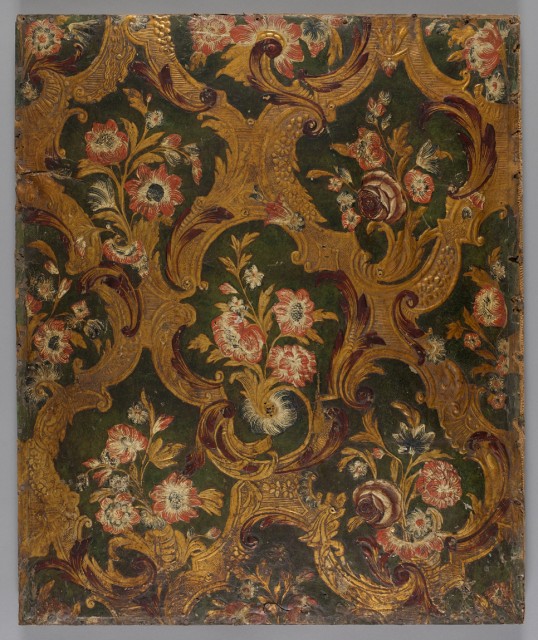Embossed and gilt leather hangings were one of the earliest known wallcoverings. Frequently referred to as Spanish leather, these wallcoverings were widely made across Europe. This example dates to the mid-18th century and is designed in the Rococo style as can be seen in the scrolling diaper or trellis framework and the asymmetrical arrangements of the floral bouquets. Always one of the most costly wallcoverings available, gilt leathers have never totally fallen out of fashion and new leather can still be purchased today. To create a piece of gilt leather for walls, the leather is first tanned. The entire surface is then covered with a layer of silver gilt and brushed with yellow varnish to give it a golden appearance. The leather is then turned upside down and pressed into a mold to emboss the surface. It is them painted in oil colors to further decorate the surface. Silver gilt was the only metal used to cover the face of the leather, as the guilds were very strict in this regard. On a recent trip to Boston I visited the Isabelle Stewart Gardner Museum and was pleasantly surprised to find an entire gallery covered with gilt leather. The antique gilt leathers have a tactile surface unlike any other wallcoverings. The layer of silver gilt reflects the light and exudes a warmth and energy not realized by other surface treatments. More contemporary embossed leathers copy the patterns of the antique examples but their use of metallic pigments in place of the silver gilt don’t have quite the same effect. To install the gilt leather hangings they were frequently tacked onto boards which were then hung on the wall. The pieces could also be stitched together. Many of the gilt leather pieces have aged very well as can be seen in this piece, while others show the ravages of time.
Tombstone
Gilt leather. The Netherlands, ca. 1750. Museum purchase through gift in memory of Josephine C. Howell and through bequest of Edith M. Henderson and from Sarah Cooper-Hewitt Fund. 1989-34-1.
Collection Record
